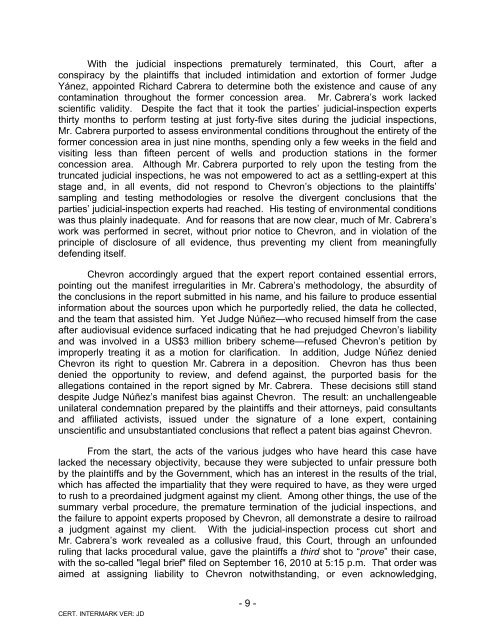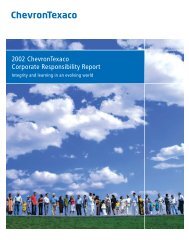-i- TO THE SUBROGATE PRESIDENT OF THE ... - Chevron
-i- TO THE SUBROGATE PRESIDENT OF THE ... - Chevron
-i- TO THE SUBROGATE PRESIDENT OF THE ... - Chevron
Create successful ePaper yourself
Turn your PDF publications into a flip-book with our unique Google optimized e-Paper software.
With the judicial inspections prematurely terminated, this Court, after a<br />
conspiracy by the plaintiffs that included intimidation and extortion of former Judge<br />
Yánez, appointed Richard Cabrera to determine both the existence and cause of any<br />
contamination throughout the former concession area. Mr. Cabrera’s work lacked<br />
scientific validity. Despite the fact that it took the parties’ judicial-inspection experts<br />
thirty months to perform testing at just forty-five sites during the judicial inspections,<br />
Mr. Cabrera purported to assess environmental conditions throughout the entirety of the<br />
former concession area in just nine months, spending only a few weeks in the field and<br />
visiting less than fifteen percent of wells and production stations in the former<br />
concession area. Although Mr. Cabrera purported to rely upon the testing from the<br />
truncated judicial inspections, he was not empowered to act as a settling-expert at this<br />
stage and, in all events, did not respond to <strong>Chevron</strong>’s objections to the plaintiffs’<br />
sampling and testing methodologies or resolve the divergent conclusions that the<br />
parties’ judicial-inspection experts had reached. His testing of environmental conditions<br />
was thus plainly inadequate. And for reasons that are now clear, much of Mr. Cabrera’s<br />
work was performed in secret, without prior notice to <strong>Chevron</strong>, and in violation of the<br />
principle of disclosure of all evidence, thus preventing my client from meaningfully<br />
defending itself.<br />
<strong>Chevron</strong> accordingly argued that the expert report contained essential errors,<br />
pointing out the manifest irregularities in Mr. Cabrera’s methodology, the absurdity of<br />
the conclusions in the report submitted in his name, and his failure to produce essential<br />
information about the sources upon which he purportedly relied, the data he collected,<br />
and the team that assisted him. Yet Judge Núñez—who recused himself from the case<br />
after audiovisual evidence surfaced indicating that he had prejudged <strong>Chevron</strong>’s liability<br />
and was involved in a US$3 million bribery scheme—refused <strong>Chevron</strong>’s petition by<br />
improperly treating it as a motion for clarification. In addition, Judge Núñez denied<br />
<strong>Chevron</strong> its right to question Mr. Cabrera in a deposition. <strong>Chevron</strong> has thus been<br />
denied the opportunity to review, and defend against, the purported basis for the<br />
allegations contained in the report signed by Mr. Cabrera. These decisions still stand<br />
despite Judge Núñez’s manifest bias against <strong>Chevron</strong>. The result: an unchallengeable<br />
unilateral condemnation prepared by the plaintiffs and their attorneys, paid consultants<br />
and affiliated activists, issued under the signature of a lone expert, containing<br />
unscientific and unsubstantiated conclusions that reflect a patent bias against <strong>Chevron</strong>.<br />
From the start, the acts of the various judges who have heard this case have<br />
lacked the necessary objectivity, because they were subjected to unfair pressure both<br />
by the plaintiffs and by the Government, which has an interest in the results of the trial,<br />
which has affected the impartiality that they were required to have, as they were urged<br />
to rush to a preordained judgment against my client. Among other things, the use of the<br />
summary verbal procedure, the premature termination of the judicial inspections, and<br />
the failure to appoint experts proposed by <strong>Chevron</strong>, all demonstrate a desire to railroad<br />
a judgment against my client. With the judicial-inspection process cut short and<br />
Mr. Cabrera’s work revealed as a collusive fraud, this Court, through an unfounded<br />
ruling that lacks procedural value, gave the plaintiffs a third shot to “prove” their case,<br />
with the so-called "legal brief" filed on September 16, 2010 at 5:15 p.m. That order was<br />
aimed at assigning liability to <strong>Chevron</strong> notwithstanding, or even acknowledging,<br />
CERT. INTERMARK VER: JD<br />
- 9 -

















